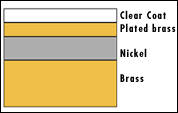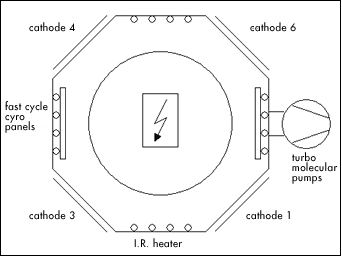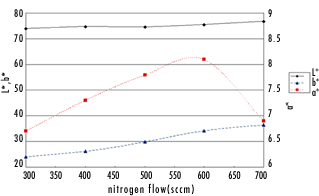By
Michiel Eerden, Process Engineer
Since the mid-90’s, physical vapor deposition (PVD) coatings have been established as the high quality finish for sanitary and door hardware in the U.S. Major American OEM’s such as Baldwin, Delta, Kohler, Moen, Price Pfister and Schlage Lock are marketing these products with long-time guarantees on their appearance. Moen received the 2000 ASM Engineering Materials Achievement Award for its development of PVD coatings on its faucet lines. PVD is a vacuum deposition technique where metal is vaporized in an atmosphere that consists of partly ionized noble or reactive gases. In the first case, a metallic layer is grown on the substrate material. In the second case, the metal reacts with the ionized gas, leading to a ceramic material. PVD ceramic coatings offer an alterative to traditional electroplating because of several characteristics: high hardness and wear resistance, no discoloration or tarnishing, high corrosion resistance and no attack by UV radiation Originally, chromium colored faucets and doorknobs were made of brass or zinc and subsequently electroplated with a nickel/chromium finish for leveling, high luster and corrosion resistance. Trends in recent years show that increasingly more products are made of lower cost materials like ABS plastic. These trends have not only led to challenges for the electroplating companies but also for the manufacturers of PVD equipment. At Hauzer, Venlo, the Netherlands, engineers have taken on this challenge and proven that all these substrate materials can be treated in a reproducible manner. Limitations
of electroplated brass
Limitations
of PVD Pre-PVD
Plating
Zinc die-cast. After a zinc die-casting process, the surface of the material may be rather rough. If the copper film does not adhere to the zinc over the entire surface, it will leave voids under the electroplated layers. During the PVD process, the products will be heated under vacuum, and entrapped gas will expand. The PVD coatings will adhere to the electroplated layers, but so called blisters will form. If the electroplating is too thin, entrapped gas may escape and the coating stack may “implode.” ABS plastic. For PVD processes, it is preferable to have the complete ABS surface covered by a metal film. This coverage enables more flexibility in fixture design (electrically conductive contact between fixture and product is necessary) and reduced outgassing of the plastic material during the deposition process. Cleaning
Prior to PVD Coating A typical cleaning line consists of baths with water-based alkaline cleaning agents, rinsing baths with city water, RO water and DI water and a vacuum or hot-air drying station. Care must be taken so that no silicon containing buffing compounds are left in or on the products when entering the cleaning line. The cleaning line must have sufficient flexibility to ensure appropriate cleaning of all substrate materials. Agents used for brass may not be suitable for zinc. The DI water in the rinsing baths has to be good enough to ensure no drying stains will form on the products. Last, the drying station has to be adjustable to enable good drying of low- and high-temperature resistant materials. PVD
Coating Process and Properties
With increased ion bombardment, the density of the coating increases (less porosity). Due to the larger compressive stress in the film, its hardness will also be larger. This means that the coatings will have a better wear resistance (higher hardness) and corrosion resistance (less porosity). In this respect, it is necessary to make a distinction between two PVD technologies: arc evaporation and sputtering. With sputtering processes, the ionization level of the metal is limited to approximately 5%. In arc evaporation, the metal will pass through a very strong electron beam, leading to ionization levels of 90% or higher. The bombardment is even stronger because the average ionization is close to two. By applying a negative potential to the substrates, these positively charged ions are accelerated toward the products, leading to the necessary ion bombardment of the growing film. As the energetic bombardment in arc evaporation processes is 35 times higher than during sputtering, arc evaporation is the favorable deposition technology for low-temperature materials like ABS plastics. Decorative PVD coating chambers are mostly equipped with arc evaporation cathodes. Figure 2 shows a schematic top view of a decorative PVD installation. The system has up to six cathode positions, which can hold both arc evaporation and magnetron sputtering cathodes. Target materials can be chosen freely, enabling production of multi-layers and metal compound coatings. For extended water vapor pumping speed, the system is equipped with fast cycle cryo panels. Products are mounted on fixtures with two- or three-fold rotation to ensure optimal coating uniformity. With a volume of approximately three sq meters and a locating height of two meters, the system is ideal for mass production of consumer goods as low cost per piece. Because the temperature resistance of several substrate materials is limited, coatings with identical colors and high quality have to be produced at economically attractive prices. The standard PVD process for electroplated brass products typically consists of the following steps:
Processes
Specific for Substrate Materials ABS plastic. In addition to temperature limitations, another problem of ABS plastic is its porosity and tendency to adsorb high amounts of water vapor. Degassing cannot be forced by heating the products to high temperatures; therefore, it has to be controlled in the vacuum chamber itself. With the normal vacuum pumps having low pumping speeds for water vapor, it takes a long time to pump down an installation to its necessary vacuum level. With the introduction of fast cycle cryo panels, the amount of time needed to pump down to a base pressure of 3E-mbar is reduced to approximately 15 minutes.
Stainless steel panels with tubing soldered to the back are mounted within the vacuum chamber. Water vapor in the chamber is adsorbed and trapped by a cooling medium with temperatures down to 150 Kelvin. In this way, the pumping speed for water vapor is increased immensely, and cycle times can be reduced to similar levels as for metal substrates. An extra benefit from the cryo panels is additional cooling for the products, opening a larger process window for heating and quality improvement by ion bombardment. PVD
Colors Ceramic coatings are made to increase the hardness and color window of the deposits. Introducing reactive gases during the deposition produces these hard coatings. The most used reactive gases are nitrogen and methane or acetylene to produce metal-nitride, metal-carbide and metal-carbonitride films. Sometimes oxygen is also used to produce oxides, oxinitrides, etc. These metals can be produced in a certain color range, depending on the metal-to-gas ratio in the film (also called stoichiometry) and the structure of the coating. To change the stoichiometry and structure of the coating and its color, arc evaporation current, bias voltage, gas flow and temperature can be used: arc evaporation current, bias voltage, gas flow, temperature. The process temperature affects the density and structure of the coating and, therefore, its color. This means that even with identical currents, bias voltages and gas flows, color difference will exist between products coated at different temperatures. With the goal to coat different substrate materials with identical colors in mind, other process parameters have to be found to counterbalance the effect of temperature. The effects of arc evaporation current, bias voltage, argon, nitrogen and acetylene flow have been examined in detail. Figure 3 shows the influence of the nitrogen flow on the color of zirconium-carbonitride coatings for a certain combination of evaporation current, argon and acetylene flow. Colors are measured in CIE-L*a*b* values.2 Zirconium is the most used target material for decorative applications in sanitary and door hardware because of its relatively wide color range. Process
Control The combination of these, specially designed installations with high flexibility and reliability and automatically controlled processes enable excellent reproducibility of a magnitude of colors on different substrate materials in multiple machines worldwide at any moment in time. Faucets assembled of brass, zinc and ABS products will show no color deviation, even if the substrate materials are purchased, electroplated and PVD coated in different locations. 1 A PVD chamber is usually operated in the E-3 or E-2 mbar range (1Torr+1.333 mbar) and has a base pressure in the E-7 mbar range. Pressures such as this can be obtained using oil diffusion or turbomolecular pumps. To obtain a vacuum on the high-pressure side of the turbo pumps and to pump down the system from atmospheric pressure a rotary vane and root pumps (forevacuum) are used. 2 Commission Internationale d’Eclairage is the most commonly used color space and is based on human perception of color. |
|
|
|
Serving
the Finishing Industries. Since 1936. |



